Daniel Batten
Peer Review:
- Ruben Mendoza (Management Consultant) 22 Jun 2022
- Margot Paez (Climate Scientist) 15 July 2022
- Sergio Sejas (Climate Scientist) 10 Aug 2022
Executive Summary
Using Bitcoin mining to combust leaking methane sources can eliminate 5.32% of all global emissions by 2045. This represents 23% of all global methane emissions: more than half the UNEP’s targeted reduction of methane of 45% by 2045.
That means that Bitcoin mining has the potential to avoid nearly 0.15°C of warming by 2045. This excludes other uses of Bitcoin such as facilitating the renewable buildout of the grid and is based purely on its ability to reduce leaking methane emissions.
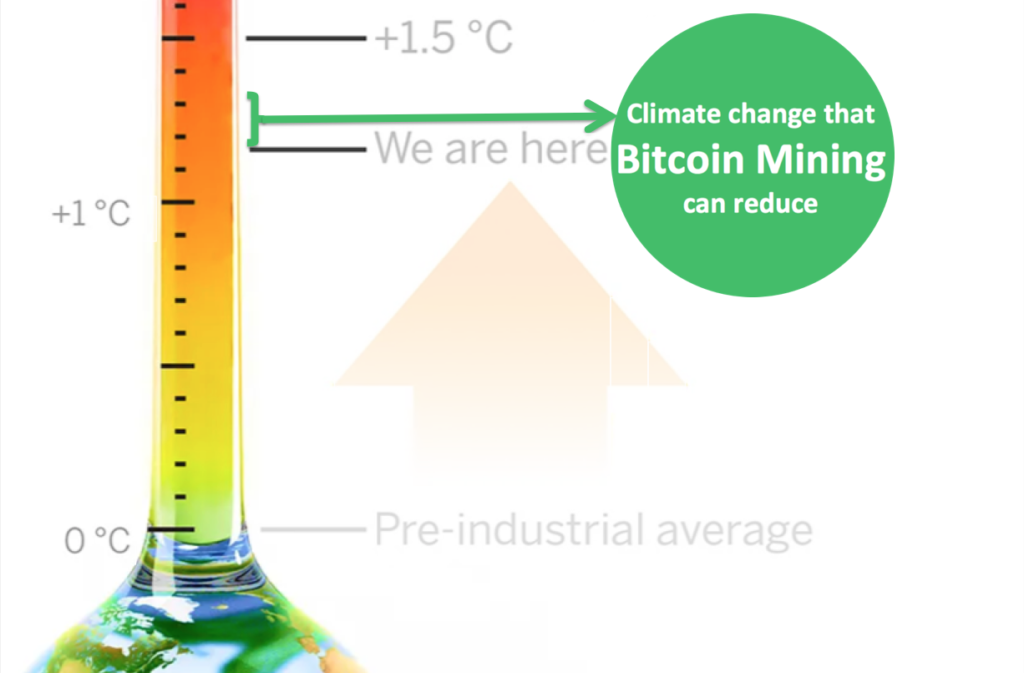
Reducing methane emissions is the fastest way to reduce global warming and complements CO2 reduction strategies. Bitcoin mining is currently the only way of reducing these methane emissions which is both technologically feasible, and does not require significant behaviour change in order to work. Bitcoin mining is also currently the only way to combust leaking methane that is both economically and logistically feasible without carbon credits or the governments of major industrialized nations needing to issue tax incentives and funding in unison. Bitcoin mining has shown early evidence of being able to scale with an exponential growth rate.
Simply put: reducing methane emissions is the strongest lever we have to slow climate change. Bitcoin mining is the fastest, economically viable hand we have upon that lever[i].
Introduction
As far as we know this is the first attempt to fully quantify the potential CO2-eq (carbon dioxide equivalent) emission reduction that Bitcoin mining can affect. We acknowledge the investigative research Nic Carter and others have done on combusting wasted methane for Bitcoin mining. Their work made this paper possible.
Bitcoin can be used to combust methane from any collectable source, including:
1. Flared (or vented) gas from the oil & gas industry
2. Landfill gas
3. Other oil & gas locations (petroleum refineries, orphaned oil wells[ii])
4. Biogas (sources include manure from intensive animal farming, wastewater, and organic waste from food & beverage production)
We only quantified the net CO2-eq impact where Bitcoin mining was the only economically viable technology able to combust that methane. Our results will give a minimum achievable target, as we only quantified the environmental benefit of combusting flared gas and landfill gas: these being the largest methane emitters, collectable by miners. In future papers, we will quantify the CO2-eq reduction possible by using Bitcoin mining with biogas or wastewater.
Clarifying Misconceptions
Unlike solar, whose environmental benefit is obvious but whose consumption of carbon (via coal furnaces used to melt silicon) is less obvious, Bitcoin mining’s energy consumption is obvious, but its environmental benefit is not immediately obvious. Perhaps for this reason, it is easy to make a premature and superficial assessment based only on energy consumption that Bitcoin has a net negative environmental impact. Such reasoning is flawed since the net impact can only be established by considering both environmental cost and benefit.
These are the seven most common misconceptions about Bitcoin mining using methane as a power source.
Misconception 1. “Burning methane releases CO2 which will increase our carbon emissions”
The reverse is true. Both CO2 and hydrocarbons like Methane (CH4) contribute to climate change. However, over a 20-year period, Methane has 84x[iii] the warming effect of CO2. Burning 1 T methane releases 2.75[iv] T CO2. So combusting methane to generate power actually decreases CO2-eq emissions to 2.75/84 = 3.27% (around 1/31) of the original level.
Misconception 2. “We should be focusing on renewable energy, not burning methane”
Focusing on cutting methane doesn’t mean we suddenly stop our transition to renewable energy – we must do both. As Inger Andersen, Executive Director of UNEP explains “Cutting methane is the strongest lever we have to slow climate change over the next 25 years and complements necessary efforts to reduce carbon dioxide[v]”
Andersen makes such a strong statement because methane
- Has an 84x higher warming effect over 20 years compared to CO2
- Has climbed relative to CO2 emissions, to 23.1%[vi] of CO2-eq emissions
- Stays in the atmosphere for only 9-12 years, meaning that the impact of reducing methane will be felt almost immediately, unlike CO2, which takes around 100 years to dissipate. UNEP estimate that a concerted effort to reduce methane can prevent 0.3 degrees of heating this decade.[vii]
Misconception 3. “Flaring is the best solution / When oil & gas companies flare methane, it removes methane anyway”
Untrue. The International Association of Energy estimates that the “global average combustion efficiency [of flare stacks] in 2020 was around 92%.”[viii] That means 8% of the methane is still released into the atmosphere. This 8% has a significant climate impact, as we will see in the calculations section, and represents some of the lowest hanging fruit in terms of how we can reduce emissions this decade.[ix]
As for flaring being the best solution, it scores poorly as a solution both in terms of effectiveness and economics (costing ~$1Million to install according to Vespene, inefficient, requiring regulatory enforcement and delivering no financial incentive to anyone) with the World Bank and other organisations calling for the outright banning of routine flaring by 2030.
Misconception 4. (Closely related to 3) “The benefits of generating power from flared gas are marginal”
At least 25% of today’s warming is driven by methane from human actions[xi]. In 2020, EDF completed a 1200-site survey of New Mexico & Texas, finding that the US Environmental Protection Agency (EPA) flare estimates were underestimated by a factor of 3.5[xii] (see below). A recent conversation I had with Chester Ney at Environmental Consultancy Group ALL4 confirmed that internal combustion is the most trusted way to all-but-remove residual methane from flared gas.
Misconception 5. “We should be using that flared gas for something more useful” – hospitals, residential heating, anything”
Let’s put aside the viewpoint that Bitcoin mining serves no use that has been countered by Alex Gladstein[xiii]. This is usually neither economically nor logistically possible. Unless the hospital or a residential housing village is built in the middle of an oilfield or adjacent to a landfill (unlikely), this power needs to be delivered via either pylon transmitted electricity at $3M/mile[xiv], or gas pipelines at $5M/mile[xv]. For this reason, data centres are typically the only location-agnostic users able to locate in the oilfield, who can start using this power and removing harmful methane immediately. Of datacenters, Mobile Bitcoin mining-based data centres are the only type of data centre that is mobile, compact and fully “interruptible” (can easily withstand changes in levels of electricity generation based on the variable flow of gas to generators). IEA has recently acknowledged cryptocurrency mining as a practice already taking place as a way to avoid flaring[xvi].
Misconception 6. “Oil companies will just use that money to do more oil exploration.”
The oil industry has generated $2.8Bln in profit every day for the last 50 years. Crusoe (partnered with Exxon) currently have a total 83 MW of capacity, which would mine approx $136,000 in Bitcoin per day. Assuming a 20% Profit to earnings ratio, this would be around $27,200 in profit per day: 0.00097% of the oil industry’s daily profit, and not likely to be sufficient to sponsor new oil exploration
Misconception 7. “It’s not carbon capture/ It’s not carbon negative”
Not true. Combusting methane that would have gone into the air is classified as Methane capture, and is recognized as one of the four forms of carbon reduction.

Misconception 8. Agriculture is the biggest methane polluter: eating less meat would solve it.
Yes, Agriculture is one of our largest sources of methane, and the UN does indeed suggest strongly that we need to move to more plant-based diets. However, even if we were to all become plant-based tomorrow, that would still leave most of our human-created methane spewing into the atmosphere each year. We need to migrate from this mentality of “not this, but that” to “this and that also.”
Misconception 9. “Regulation is the best way to curb emissions”
It’s funny to hear people say “regulation is the best way to mitigate methane” when the Environmental regulators themselves, The Environmental Protection Agency, (EPA) say regulation is not the best way to mitigate methane: incentives are. It is literally on their website:
“Why aren’t efforts to capture and profitably use methane emissions more widespread?” asks the EPA. They understand better than most that carrot > stick; that regulation is the fallback where incentives don’t exist.
Regulation is the fallback where incentives don’t exist
Quantifying the impact of Bitcoin Mining
Step 1a: Quantify current levels of methane from flaring and venting in the oil and gas industry
Currently, there are 8 Mt Methane (240 Mt CO2-eq) emitted into the atmosphere each year.[xvii]
However, research by the Environmental Defense Fund (EDF) subsequently revealed this was underestimated by a factor of 3.5[xviii] using VIIRS[xix] a satellite assessment of 1200 Flare sites in the Permian Basin.[xx]
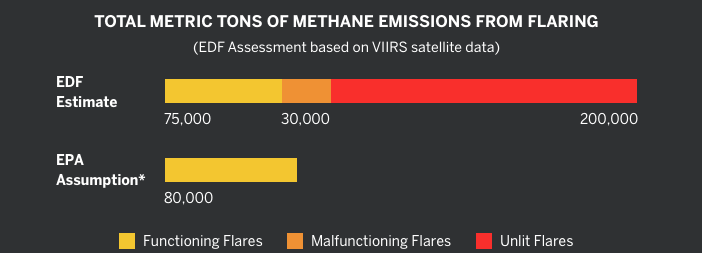
The next question we asked ourselves was “is this 3.5x underestimation indicative of global underestimation?” The only way to definitively answer this would be satellite surveying of methane emissions globally. This has never been done, and for geopolitical reasons is unlikely to occur in the near future. In lieu of such a survey, however, there are three data points, which suggest that the 3.5x underestimate is in fact a lower bound, and the true level of underestimation is in fact higher.
- The US has stronger regulations than in Africa, the Middle East and large parts of Asia including the former Soviet Union. While the EU has stronger environmental regulations than the US, there is relatively little gas flaring in the EU. We hypothesize that countries with less environmental regulation would be likely to do less flaring and more venting, causing higher methane emissions.
- Anecdotal evidence supports the hypothesis that in less well-regulated parts of the world outside North America, venting is more common. For example, Irakulis-Loitxate analyzed Turkmenistan satellite footage and found that an estimated “83% of the identified emitters are inactive flares: 30 that directly vent gas to the atmosphere.[xxi]”
- One study (Johnson and Coderre, 2009) found that “Industry-wide total volumes of gas vented at primary production facilities are similar to those being flared.[xxii]”
The Permian Basin study, while showing methane emissions in that area were 3.5x higher than estimates, also showed that only “10% of flares were either unlit … or burning only part of the gas they were releasing”. This compares favourably to Turkmenistan’s 83% and the implied 50% industry-wide venting total in the Johnson and Coderre study.
These research findings all support the thesis that globally, the actual underestimation of methane emissions from flaring/venting is likely to be higher, not lower, than the 3.5x multiplier in the relatively well-regulated Permian Basin locale.
From here we can extrapolate conservative likely Methane global emissions from flaring and venting:
Total minimum methane emissions: 3.5 x 8 Mt Methane = 28 Mt Methane =
840 Mt CO2-eq per year (see 1a above)
Total 2021 global CO2-eq emissions: 40.8 Gt CO2-eq[xxiii]
Global emissions % from oil & gas flaring/venting: 840/40800 = 2.06%
Step 1b: Quantify maximum flare/vent reduction possible through Bitcoin mining[xxiv]
1. Current # alternative uses for flared/vented gas: 32% (calculated as below)
Offsite uses: 30% +
Onsite uses: 2% (See Onsite uses below)
Offsite uses:
Gas Flare Capture Company Capterio found that 30% of all flaring occurs within 5km of a gas pipeline[xxvi]. This is sufficiently close to a pipeline so uses other than Bitcoin mining is valid and should be seriously considered despite the logistical and economic challenge of building additional gas pipelines because capture is environmentally preferable to combustion.
In the same study, Capterio also cited 5 reasons why despite proximity to a gas pipeline, the gas is still flared. For the purpose of this study and so as not to overstate the use case of Bitcoin mining, we assume that these reasons can be overcome, and we only considered Bitcoin mining for those sites more than 5km from a gas pipeline.
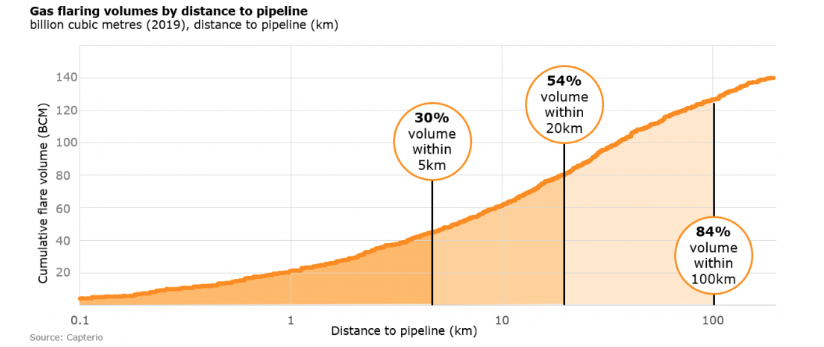
Onsite uses:
In this analysis[xxvii], the International Energy Agency presents data mentioning that the oil operators use the ‘associated’ gasses on-site to some extent by reinjecting them to the wells. Anecdotally, these associated uses appear to represent less than 2% of all ‘associated’ gasses, the remainder of which end up being flared/vented.
2. % of oil/gas sites accessible to Bitcoin mobile mining units
Total % politically feasible: 94.1%[xxviii]. Of this, most of the world’s oil fields are located in flat deserts or arctic regions, with a smaller percentage being at river deltas or offshore[xxix]. Offshore oil rigs are still able to accommodate Bitcoin miners, so a relatively small percentage is likely to be completely inaccessible to mobile Bitcoin mining units. We have used an estimated 80/20 split for oil fields that are topographically accessible/inaccessible. So political/topographical accessibility % is 0.941×0.8 = 75.3%. We also assume a 5% long tail of smaller oil fields that may be uneconomic for Bitcoin miners to mine. So overall accessibility = 71.5%[xxx]
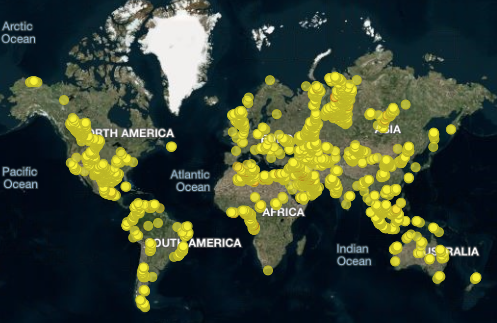
3. CO2-eq reductions from Bitcoin mining.
Based on 92% flaring efficiency (ie: the IEA’s calculation that flaring removes 92% of methane)
1 Mt Methane produces 2.75 Mt CO2
Currently 28 Mt Methane from flaring/venting = 840 Mt CO2-eq (using the IEA methodology of multiplying weight of methane by its 100-year Global Warming Potential of 30x to arrive at a CO2-eq emissions figure.)
Internal combustion (as used for Bitcoin mining) elimination of methane emissions = 99%[xxxi]
@ 99% methane elimination:
=> 28×0.01 = 0.28 Mt Methane still released into atmosphere (7 Mt CO2-eq)
The remaining (28×0.99) Mt Methane combusts, producing (27.72×2.75) = 76.23 Mt CO2
=> Total potential CO2 reduction = 840 – (76.23+7) = 756.77 Mt CO2-eq.
4. Total GHG emission reduction possible by Bitcoin mining using flared/vented gas from the Oil&Gas industry = 756.77x 0.715 x (1-0.32)= 368.02 Mt CO2-eq
This represents: 368.02/40800 = 0.90% of all CO2-eq Global Emissions.
Cross-referencing:
This figure of 840 Mt CO2-eq is marginally less than the CoinShares’ figure of 928 Mt CO2. The main reason for the variance is that Coinshares’ used a different methodology, using a study that had pre-factored in the efficiency of flaring when partially lit and unlit flares were factored in, whereas we used the IEA official flaring efficiency number and adjusted by 3.5x underestimation multiplier revealed in EDF Satellite Surveys.
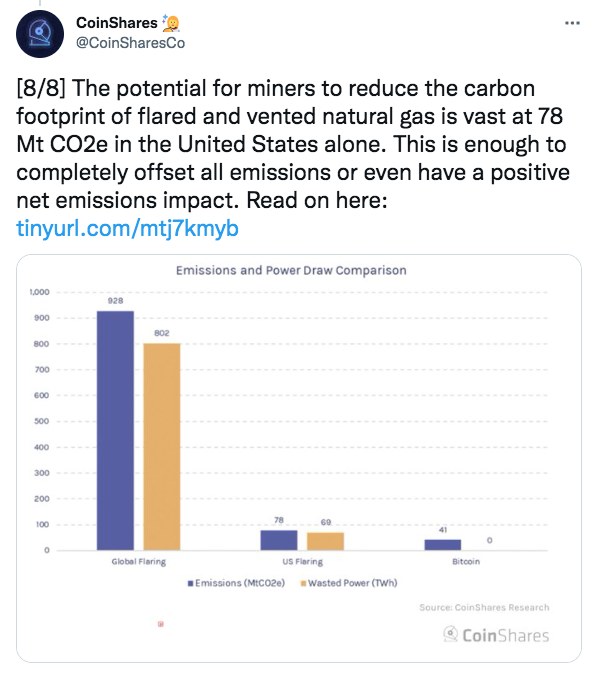
Exponential Growth: We fully expect that over the next 10 years there will be exponential growth in the deployment of Bitcoin mobile miners to oilfields. Already we have seen early evidence of that trend. For example, one year ago there was only one active mining company using flared/vented methane from the oil & gas industry. At the time of writing, there are six[xxxii].
Step 2a: Quantify current levels of methane from landfills
EPA estimates that Landfill methane constitutes 15%[xxxiii] of all global methane emissions
So based on EPA data, 15%x23.1% (Methane’s contribution to global CO2-eq emissions[xxxiv]) = 3.47% of all global CO2-eq emissions are from Municipal solid waste (MSW) landfills.
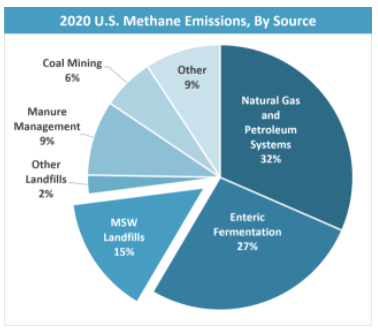
However research by NASA aerial satellites subsequently revealed that total methane emissions when actual satellite measurements were taken were 2.27x[xxxv] higher than the EPA estimates which used crude estimates of total organic waste estimates, and decay rates rather than satellite data.[xxxvi]
So true landfill contribution is 7.87% of all global CO2-eq emissions
Step 2b: Quantify maximum landfill reduction possible through Bitcoin mining
1. Future alternative uses for landfill gas: 9.3 %[xxxvii]. (0.907 have no alternative)
2. % of Landfill sites accessible to Bitcoin mobile mining units:
- a. Assuming the US is a representative sample, there are currently 2600 landfills[xxxviii], of which 2000 are not utilizing their methane for any purpose (0.769)
- b. Total % politically feasible: 0.941
- c. Topographical accessibility of landfills: 0.95[xl]
- d. Percent with sufficient methane content to be profitable to mine: 0.95[xli]
- e. Exclude tail (landfills that are too small to be worth mining) 0.95[xlii]
- f. Methane that is utilizable for power combustion = 0.99[xliii]
3. Percentage that can be mined is 0.907×0.769×0.941×0.95×0.95×0.95 = 55.71%
=> Targeting landfills, Bitcoin mining can reduce 0.5571×7.867 = 4.38% of all global CO2-eq emissions
Other applications
Bitcoin mining can viably turn methane into a power source for mining whenever
– There is a large volume of methane
– The emissions are logistically easy to collect
– The sources of emission are not near large population centres, gas pipelines or high-voltage pylons that can transfer power to the grid.
All three conditions are true for the vast bulk of intensive animal farming and wastewater treatment. This makes both potential sources for Bitcoin miners, with farm biogas projects already completed in UK and Mexico[xliv] and a wastewater Bitcoin mining project now running in Guatemala[xlv]
Our calculations show that emissions from agricultural biogas and wastewater are 1.09% and 1.34% of total global CO2-eq emissions respectively. Orphaned oil wells contribute a still significant 0.20% of GHG emissions. Until we research these use cases further, we have excluded these figures from our total Bitcoin mining impact calculations.
Conclusion
Bitcoin mining can eliminate 0.90 + 4.38 = 5.28% of all global CO2-eq emissions. This represents (5.28/0.231) = 22.9% of all global methane emissions: slightly more than half the UNEP’s 45% methane reduction target.
Incredibly, discussing the IPCC’s target to limit global warming to under 1.5°C, UNEP recently stated
“The 1.5°C target cannot be achieved without reducing methane emissions by 40-45% by 2030. Reduction of this magnitude would avoid nearly 0.3°C of warming by 2045 and complement long-term climate change mitigation efforts.”[xlvi]
That means Bitcoin mining has the potential to achieve half our methane reduction target.
That also means that Bitcoin mining has the realistic potential to help humanity avoid nearly 0.15°C of warming by 2045. In theory, other technologies including Iron Oxide exist that can be used to reduce methane from the atmosphere. However, these and other technologies bring additional expenses and logistical issues (which is why they are not currently being used), whereas Bitcoin mining provides revenue, and has shown itself able to overcome these logistical hurdles.
It is important to restate that it is the unique combination of being location-agnostic, mobile and interruptible that makes Bitcoin mining the only economically feasible use case for the two major sources of leaking methane emissions examined in this paper.
Examining other methods offered by IPCC and UNEP to reduce methane, we see that Bitcoin provides an overlooked role that is high impact and very fast acting.
Bitcoin mining requires none of the global social or behavioural change that measures such as moving to plant-based diets will entail (though it does not address additional issues such as increasing water scarcity that arises from maintaining livestock), Bitcoin mining is not a replacement for these essential social change measures. However, Bitcoin mining does not have to wade through the lag of human inertia and change–resistance in order to start making an impact.
Critically, because Bitcoin mining also makes business sense to both the emitter and the miner, it can take place through private business deals. While carbon credits, government regulation, and government funding could accelerate Bitcoin mining, unlike other means Bitcoin mining does not rely on things to make an impact, as demonstrated by the existing fast-growing number of Bitcoin miners using leaking methane emissions.
Future research: we have not calculated Bitcoin mining growth rates and constraints. We invite others to pick up and develop this line of research, and any assumptions previously mentioned in this document.
Notes: 5 Sept 2022. Feedback by Lorenzo Vallecchi suggests strongly that the estimate of flared methane is too high (recalibrated estimate would reduce Bitcoin’s potential to mitigate only 0.14°C. Dennis Porter’s quantification of orphaned oilwells conversely suggests strongly that the estimate of orphaned oilwell emissions was too low, and that it deserves being added to the study. Recalibrated estimate has a roughly +0.03°C consequence. So overall estimate may increase to 0.17°C. I will recalculate these precisely when I have time. Thanks to both contributors for their analysis.
[i] We investigated many technologies capable of reducing methane emissions. Several of them including Methane Oxidation are documented in this UN Climate Change Video. Of the subset of technologies that were available today, we found that the only solution which was a net income source, rather than a net cost, was Bitcoin mining. As such, we consider it to be the fastest-acting solution that is both economically and technologically viable.
[ii] oil or gas wells that have been abandoned by fossil fuel extraction industries. These wells may have been deactivated because of economic viability, failure to transfer ownerships … or neglect and thus no longer have legal owners responsible for their care.
https://en.wikipedia.org/wiki/Orphan_wells
[iii] https://www.unep.org/news-and-stories/speech/methane-action-tackling-warming-planet
[iv] “16 grams of methane (one mole) when completely burned produces 44 grams of carbon dioxide (one “gram molecular weight” or mole).” Therefore 1 T Methane releases 44/16 = 2.75 T CO2
https://static.berkeleyearth.org/memos/fugitive-methane-and-greenhouse-warming.pdf
[v] https://news.un.org/en/story/2021/05/1091402
[vi] 23.1% is an average of four different sources which calculated methane’s contribution to total emissions using slightly different methods https://ourworldindata.org/greenhouse-gas-emissions (17.3%) https://www.unep.org/news-and-stories/story/methane-emissions-are-driving-climate-change-heres-how-reduce-them (30%) https://www.epa.gov/gmi/importance-methane (20%)
https://www.edf.org/climate/methane-crucial-opportunity-climate-fight (25%)
[vii] “Cutting human-caused methane by 45 per cent this decade would keep warming beneath the threshold agreed by world leaders. This alone would avoid nearly 0.3°C of global warming.” https://www.unep.org/news-and-stories/story/new-global-methane-pledge-aims-tackle-climate-change
[viii] https://www.iea.org/reports/flaring-emissions. Note: there are varying estimates of flaring efficiency. D M Leahey
et al arrive at a figure of 68% flaring efficiency. https://pubmed.ncbi.nlm.nih.gov/15666465/. The EPAs estimate of 98% appears to have come from a paper published in 1983 https://www3.epa.gov/ttnchie1/old/ap42/ch13/s05/reference/ref_01c13s05_jan1995.pdf before more accurate aerial satellite monitoring was possible. We have used the 2020 figure due to the recency, sophistication of monitoring and volume of sites monitored.
[ix] See section Quantifying the Impact of Bitcoin Mining in this document
[x] Crusoe Energy has achieved 99.9% combustion efficiency. https://techcrunch.com/2021/04/26/crusoe-energy-is-tackling-energy-use-for-cryptocurrencies-and-data-centers-and-greenhouse-gas-emissions/
[xi] https://www.edf.org/climate/methane-crucial-opportunity-climate-fight
[xii] https://www.permianmap.org/flaring-emissions/ .This study is more reliable than EPA figures, because it used actual data from 1200 aerial surveys, as opposed to estimates.
[xiii] https://twitter.com/gladstein
[xiv] According to the National Grid it costs £1.6m per kilometre (USD3.16m per mile) to set up pylon-transmitted electricity. https://conversation.which.co.uk/home-energy/pylons-should-they-be-beautiful-or-cost-effective/.
[xv] https://www.gem.wiki/Oil_and_Gas_Pipeline_Construction_Costs
[xvii] https://www.iea.org/reports/flaring-emissions. The 100-year GWP is used to derive CO2e. (GWP = Global Warming Potential). Methane’s 100-year GWP is about 28x CO2 according to Climate Change Connection https://climatechangeconnection.org/emissions/co2-equivalents/. IEA use a GWP of 30. As they are a highly respected international agency with specialist knowledge of energy, we have used their figure.
[xviii] https://www.edf.org/climate/methane-crucial-opportunity-climate-fight
[xix]Visible Infrared Imaging Radiometer Suite
[xx] https://www.permianmap.org/flaring-emissions/
[xxi] https://eartharxiv.org/repository/object/2380/download/4881/
[xxii] https://www.sciencedirect.com/science/article/pii/S1750583612000357 (ERCB, 2009a, Johnson and Coderre, 2011).
[xxiii] https://www.iea.org/reports/global-energy-review-co2-emissions-in-2021-2
[xxiv] We use “Bitcoin mining” as shorthand for “Bitcoin and other Proof-of-Work-based crypto mining”
[xxvi] https://capterio.com/insights/minimise-flaring-gas-near-existing-pipelines
[xxviii] https://www.worldbank.org/en/programs/gasflaringreduction/global-flaring-data. Total flared gas volume: 143410.53 million m3. (This figure appears to dynamically update, so the latest total may be marginally different to the value at the time of writing). We excluded China (2509 Mm3, crypto mining ban) and Libya (5999 Mm3, political instability) from this => 94.1% politically feasible. We note that these figures are for flaring not venting. The percentage of politically inaccessible regions when venting is factored in may vary slightly. This consideration warrants further research.
[xxix] https://www.scientificamerican.com/article/why-is-oil-usually-found/
[xxx] While possible that other countries may impose Bitcoin mining bans, it is also possible that China will un-ban select-purpose flare-gas only mining to help reduce GHG emissions. Based on this logic we have assumed the overall number of countries politically accessible will remain at 94.1%. We have also made macro-political assumptions such as the World not being at war, and the Russia-Ukraine war not being protracted. Should these assumptions prove incorrect, the number of accessible sites will decrease.
[xxxi] https://coinshares.com/research/bitcoin-mining-network-2022
[xxxii] Crusoe Energy, Giga Energy, gam.ai, jaienergy.com, Upstream Data, nakamotor.io
[xxxiii] https://www.epa.gov/lmop/basic-information-about-landfill-gas. In the absence of a global figure for the percentage of methane emissions coming from landfill emissions, current analysis extrapolates the 15% from the 2020 U.S. figures to make a global estimation. Using the same reasoning from our Oil&Gas flaring analysis where we found venting was more likely in nations that were less well regulated, true global percentage may be higher. However, in this case, small open dumps will decay aerobically, therefore not producing methane. We postulate that these two factors will counterbalance each other.
[xxxiv] See footnote vi above
[xxxv] https://www.reuters.com/business/sustainable-business/methane-menace-aerial-survey-spots-super-emitter-landfills-2021-06-18/ The comment that landfills were in fact contributing 43% of total methane emissions suggests that EPA data was underestimated by 43%/15% = 2.87x. However, we could find no supporting data for this 43% statement. We therefore used the 2.27x underestimation for large Californians landfills, assuming that this factor is based on the inherent inaccuracies of previous reporting methods and so likely to hold true globally.
[xxxvi] EPA’s underestimate of flaring/venting was out by an even larger factor (https://www.permianmap.org/flaring-emissions/ gives 305,000 MT (EDF est) vs 80,000 MT emissions from flaring EPA est) => actual satellite data was at least 3.5x higher than EPA estimates.
[xxxvii] Adam Wright, CEO of a Bitcoin mining company using landfill gas, Vespene revealed that 482 out of 2600 or 18.5% was deemed suitable by EPA for methane gas extraction due to logistical issues. The rate at which these alternative uses has been explored has been slow to date. Over the last 5 years the number of landfill sites whose methane could be used, but was not being utilized reduce from 482 to 477 (5 fewer landfills; 0.2% of total landfills). Wright estimates it is therefore unlikely that more than half of the 482 “candidate” landfills will find other uses for their gas in the next 5 years. We have used the figure of 241 as a feasible upper bound.
[xxxviii] If anything, this assumption can only under-represent total methane emissions from landfills, as many areas will be less well regulated and therefore more likely to be venting than flaring landfill gas
[xxxix] Assumed to be similar to oil/gas exclusions of 94.1%. See footnote 15 above.
[xl] Adam Wright, Vespene, confirmed that all US-based landfills will be accessible to mobile Bitcoin mining units. (We have used the 0.95 figure in the event of exceptions outside of the US).
[xli] For active landfills, 50-55% of their total gas emissions is methane. Bitcoin mining can work up to a threshold of 37% methane. Once a landfill closes, it loses 1% methane concentration per year. So if we conservatively say that a landfill must have 40-45% methane to be profitable for Bitcoin miners, this still represents all active landfills and all landfills that have been closed for less than 10 years, which is 95% of the total US landfills. (Source: Adam Wright, Vespene).
[xlii] Statistical assumption that the size of landfills will have a “long tail” of landfills that represent a small overall percentage of methane emissions. 30% of all landfills (smaller ones) may represent 5% of total methane emissions for example, and all be too small to be mined profitably. Again, as unit economics come into play and mining efficiency and innovation improves it may be possible to “mine” almost all landfills profitably, irrespective of size.
[xliii] https://coinshares.com/research/bitcoin-mining-network-2022. Coinshares’ research suggests 99% of methane can be utilized for power generation using internal combustion.
[xliv]Mexico www.biomining.mx , Wales, UK https://www.marketwatch.com/story/how-farmers-are-using-cow-manure-to-power-crypto-mining-operations-11623260105
[xlv] https://bit.ly/3LFp8qA
[xlvi] https://www.unep.org/explore-topics/energy/what-we-do/methane/methane-everything-you-need-know
